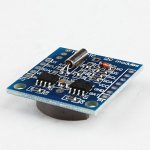I try to read and write to the 24C32 module in this "Tiny I2C RTC DS1307 AT24C32".

According to the seller includes one 32k RAM module. My problem with it is that I apparently can not address more than 256 bytes.
I tested it with this code.
Over address 255 I read incorrect data.
I have investigated the module with a magnifying glass and on the little chip there is written 24C32AN, so it should be able to contain 32768 bits.
What am I doing wrong?
By the way - I have no problem setting and reading the time with I2C commands.

According to the seller includes one 32k RAM module. My problem with it is that I apparently can not address more than 256 bytes.
I tested it with this code.
Code:
#PICAXE 08M2
#No_Data
i2cslave %10100000, i2cfast, i2cword
pause 50
for w4 = 0 to 4095
writei2c w4, (17)
pause 20
next w4
sertxd ("End writing",cr,lf)
for w4 = 0 to 300
readi2c w4, (w10)
pause 20
sertxd (#w4,"=",#w10," ")
next w4I have investigated the module with a magnifying glass and on the little chip there is written 24C32AN, so it should be able to contain 32768 bits.
What am I doing wrong?
By the way - I have no problem setting and reading the time with I2C commands.


